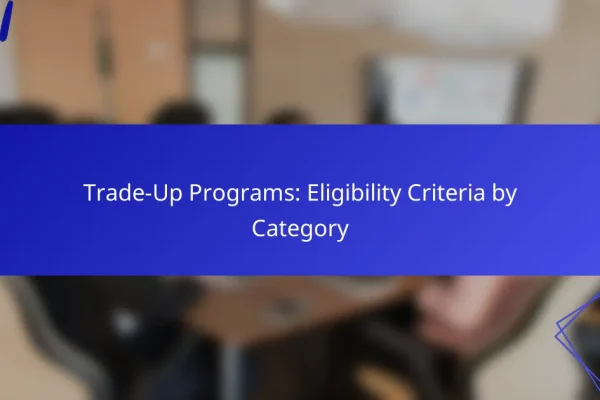What are the eligibility criteria for Trade-Up Programs?
To participate in Trade-Up Programs, devices must meet specific criteria regarding age, condition, proof of purchase, and geographic location. Understanding these requirements can help streamline the trade-in process and ensure a successful transaction.
Device age requirements
Most Trade-Up Programs require devices to be within a certain age range, typically between one to three years old. Older devices may not qualify for trade-in, while newer models are often prioritized. Check the program guidelines for specific age limits applicable to your device type.
Condition of the device
The condition of your device plays a crucial role in eligibility. Devices should be functional and free from significant damage, such as cracked screens or water damage. Many programs categorize devices into conditions like “good,” “fair,” or “poor,” affecting the trade-in value offered.
Proof of purchase
Providing proof of purchase is often necessary to validate ownership and eligibility for the Trade-Up Program. This can include receipts, invoices, or order confirmations. Ensure that the documentation clearly shows the purchase date and device details to avoid complications.
Geographic restrictions
Some Trade-Up Programs may have geographic restrictions, meaning they are only available in specific countries or regions. Verify if the program operates in your location and whether any additional terms apply. For instance, certain promotions may only be valid in the United States or within the European Union.
How do I determine if my device qualifies for a Trade-Up?
To determine if your device qualifies for a Trade-Up, check the specific criteria set by the manufacturer or retailer. Generally, devices should be in good working condition, free of major damage, and meet any age or model requirements specified in the program.
Check manufacturer guidelines
Each manufacturer has its own guidelines for Trade-Up eligibility, which typically include criteria such as device age, model, and condition. For instance, many programs require devices to be less than two years old and fully functional without significant cosmetic damage.
Visit the manufacturer’s website or contact customer service for detailed eligibility requirements. This will help you understand what specific aspects of your device will be evaluated during the Trade-Up process.
Use online eligibility tools
Many retailers and manufacturers offer online tools to quickly assess your device’s eligibility for a Trade-Up. These tools often require you to input your device’s model and condition, providing instant feedback on whether it qualifies.
Utilizing these tools can save you time and help you avoid common pitfalls. Ensure you have accurate information about your device’s specifications and condition to get the most reliable results.
What devices are eligible for Trade-Up Programs?
Trade-Up Programs typically accept a range of devices, including smartphones, laptops, tablets, and wearable technology. Eligibility often depends on the device’s condition, brand, and model, so it’s crucial to check specific program requirements.
Smartphones from major brands
Most Trade-Up Programs accept smartphones from leading manufacturers such as Apple, Samsung, Google, and Huawei. Devices should generally be in good working condition, without significant damage or defects. Common trade-in values can range from low tens to several hundred USD, depending on the model and age.
Before trading in, ensure that your smartphone is unlocked and that all personal data is erased. This not only protects your privacy but also may increase the device’s value during the trade-in process.
Laptops and tablets
Laptops and tablets from major brands like Dell, HP, Apple, and Lenovo are often eligible for trade-in. Similar to smartphones, the condition of the device plays a significant role in determining its trade-in value, which can vary widely based on specifications and age.
When preparing a laptop or tablet for trade-in, remove all personal information and reset the device to factory settings. This step is essential for both security and maximizing the potential trade-in value.
Wearable technology
Wearable devices, including smartwatches and fitness trackers from brands like Apple, Fitbit, and Garmin, can also qualify for Trade-Up Programs. The eligibility criteria usually focus on the device’s functionality and physical condition.
Before trading in a wearable device, ensure that it is fully functional and free from major scratches or damage. Some programs may require the original packaging or accessories, which can enhance the trade-in value.
What are the benefits of participating in a Trade-Up Program?
Participating in a Trade-Up Program offers significant advantages, including cost savings on new purchases and a positive environmental impact. These programs allow consumers to exchange older products for discounts on newer models, making upgrades more affordable while promoting sustainability.
Cost savings on new purchases
One of the primary benefits of a Trade-Up Program is the potential for substantial cost savings. By trading in an older item, consumers can receive a discount that typically ranges from 10% to 30% off the purchase of a new product. This can make higher-end models more accessible.
To maximize savings, research the trade-in value of your item before participating. Many retailers provide online tools to estimate how much you can save based on the condition and model of your old product. Be mindful of any specific conditions that might affect the trade-in value, such as cosmetic damage or missing accessories.
Environmental impact reduction
Trade-Up Programs contribute to environmental sustainability by encouraging the recycling and repurposing of old products. This helps reduce electronic waste, which can be harmful to the environment if not disposed of properly. By participating, consumers play a role in minimizing landfill contributions.
Additionally, many companies ensure that traded-in products are either refurbished for resale or recycled responsibly. This not only conserves resources but also reduces the carbon footprint associated with manufacturing new products. Consider choosing programs that prioritize eco-friendly practices to enhance your positive impact.
How does the Trade-Up process work?
The Trade-Up process allows you to exchange your old device for credit towards a new purchase. It involves submitting your device details, receiving an offer, and then shipping your device to complete the transaction.
Step 1: Submit your device details
Start by providing accurate information about your device, including its model, condition, and any accessories included. This information is crucial for generating a fair offer based on the current market value.
Be honest about the condition of your device, as discrepancies may lead to adjustments in the final offer. Common categories include “like new,” “good,” or “fair,” which help determine the trade-in value.
Step 2: Receive an offer
After submitting your device details, you will receive an offer that reflects its estimated trade-in value. This offer is typically valid for a limited time, so review it promptly to avoid missing out.
If you accept the offer, it will outline the next steps and any conditions that apply. Keep in mind that offers can vary significantly based on the device’s brand, model, and condition.
Step 3: Ship your device
Once you accept the offer, you will need to ship your device to the designated address. Most programs provide a prepaid shipping label to simplify this process.
Ensure that your device is securely packaged to prevent damage during transit. It’s advisable to remove any personal data and factory reset the device before shipping to protect your privacy.
What are common misconceptions about Trade-Up Programs?
Many people mistakenly believe that Trade-Up Programs are only beneficial for those looking to upgrade to the latest model, or that they always guarantee a high return on their old items. In reality, these programs can offer various advantages, including cost savings and environmental benefits, regardless of the item’s condition or age.
Eligibility Requirements
Eligibility for Trade-Up Programs typically depends on the item being traded in and the specific terms set by the program provider. Most programs require the item to be in working condition, while some may accept items with minor cosmetic damage. It’s essential to check the specific guidelines of the program to ensure your item meets the criteria.
For example, electronics often need to be functional and free of significant defects, while clothing may only need to be clean and undamaged. Additionally, some programs may have age restrictions, only accepting items released within a certain timeframe.
How to Evaluate Your Trade-In Value
To determine the trade-in value of your item, research similar items on resale platforms or consult the program’s valuation tool if available. Many Trade-Up Programs provide an estimated value based on the item’s condition, age, and market demand. This can help you gauge whether the offer is fair.
Consider factors like brand reputation and original purchase price, as these can significantly influence the trade-in value. For instance, a well-maintained smartphone from a popular brand may fetch a higher value compared to a lesser-known model.
Common Pitfalls to Avoid
One common pitfall is neglecting to clean or repair the item before trading it in. A well-presented item can often lead to a better trade-in offer. Additionally, failing to read the fine print can result in unexpected fees or conditions that diminish the value of your trade.
Another mistake is not comparing offers from different programs. Some providers may offer better deals than others, so it’s wise to explore multiple options before making a decision. Always keep an eye on promotional periods when trade-in values might be higher.




